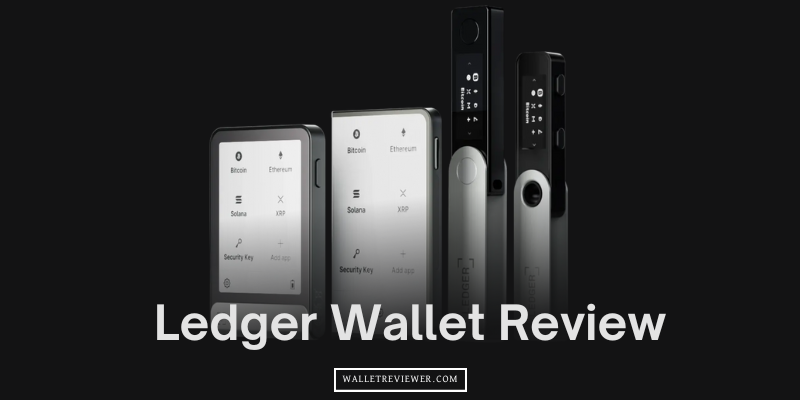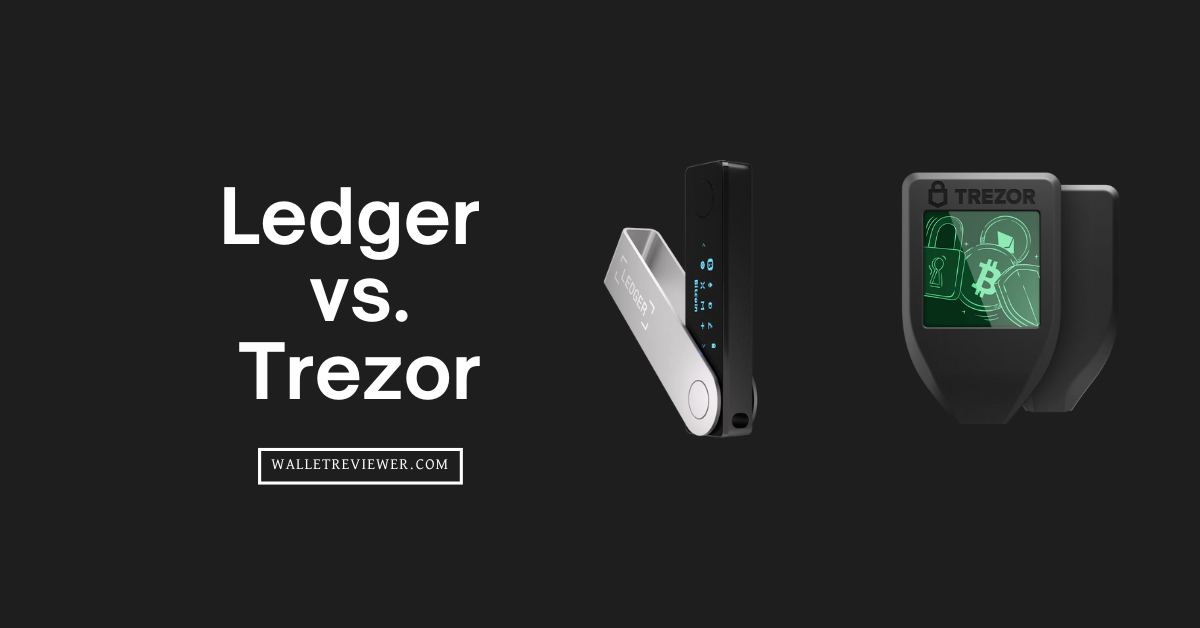Ledger remains one of the most trusted crypto hardware wallet options in 2025 for safely storing crypto and NFTs. It works with thousands of coins and gives full control over your private keys. Along with strong security, Ledger also offers support for DeFi apps and third-party wallets, making it a complete solution for serious investors.
In this Ledger wallet review, you’ll learn how each model works, which features matter most, and how it compares to other cryptocurrency wallets like Trezor. We’ll also cover the Ledger Live app, real use cases, pros and cons, and help you pick the right Ledger hardware wallet for your needs.
Ledger Wallet Review: What Is It?
The Ledger wallet is a hardware wallet used to store and manage cryptocurrencies securely. It is made by a French company called Ledger, founded in 2014. The company is well-known in the crypto industry for offering the best cold storage wallets that are widely used by both beginners and advanced users.
Now, Ledger wallets keep your crypto private keys offline, which means hackers cannot access your funds remotely, even if your computer gets hacked or infected.

Ledger currently offers 4 main products: Ledger Nano S Plus, Ledger Nano X, Ledger Flex, and Ledger Stax. All these devices support over 5,500+ coins and tokens, including Bitcoin (BTC), Ethereum (ETH), USDT, XRP, Solana, and many others. You can manage these assets using Ledger Live, which is their official desktop and mobile app.
Ledger wallets use a Secure Element chip (CC EAL5+), which is the same technology used in passports and credit cards. This chip protects your private keys and ensures the highest security standards. Ledger has also partnered with many crypto platforms, including Coinbase, which shows how trusted it is across the industry.
Types of Ledger Hardware Wallets Review
We found 4 types of products during our Ledger wallet review.
- Ledger Stax
- Ledger Flex
- Ledger Nano S Plus
- Ledger Nano X
Here is a quick review of Ledger wallets
1. Ledger Nano S Plus: Best for beginners

The Ledger Nano S Plus is a compact and secure hardware wallet launched in June 2022. It weighs just 21 g and measures 62.39 × 17.40 × 8.24 mm, similar to a USB stick. It features a 128×64‑pixel OLED display under a brushed stainless steel cover, giving it a solid feel.
Inside, it uses the CC EAL5+/EAL6+ certified Secure Element chip (ST33K1M5), the same level of protection used in credit cards, passports, and SIM cards. The device connects via USB‑C and lacks Bluetooth or battery, so it must stay plugged into a computer or Android device during use. (Read Ledger Nano S Plus review)
Key Features
- High-security chip: The CC EAL5+/EAL6+ Secure Element (ST33K1M5) protects private keys offline. It resists laser, glitch, and electromagnetic attacks, matching bank-grade safety.
- Large app capacity: It has 1.5 MB of storage, allowing up to 100 crypto apps at once. Previous models supported only 6 apps, making this a major upgrade.
- Durable, user-friendly build: It is lightweight and sturdy. The OLED screen with two buttons offers a clear transaction review. Brushed stainless steel gives it durability.
- Affordable price: Priced at approximately $79, it delivers high security and storage capacity at a lower cost than the Nano X.
2. Ledger Nano X: Best for active users
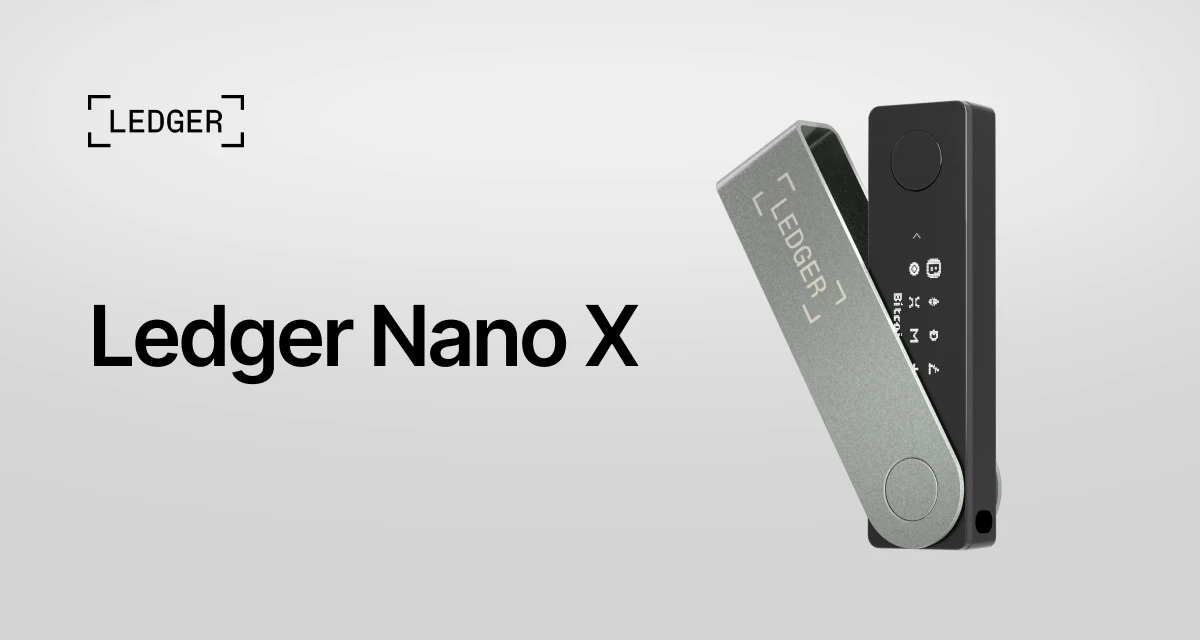
The Ledger Nano X is a portable hardware wallet released by Ledger in May 2019. It is built with a certified secure element chip (ST33J2M0) and Ledger’s proprietary operating system, ensuring private keys remain offline and protected at all times.
The device measures 72 mm × 18.6 mm × 11.75 mm, weighs 34 g, and features a brushed stainless steel casing with a plastic interior. It includes a built-in 100 mAh lithium-ion battery that provides several hours of active use and can last months when idle. Users can connect the Nano X via USB‑C or Bluetooth. With Bluetooth, it supports management through smartphones (iOS/Android) using the Ledger Live app. (Ledger Nano X review)
Key Features
- Secure Element & Ledger OS: The Nano X Ledger wallet uses a CC EAL5+-certified secure element (ST33J2M0) and Ledger’s proprietary OS. Private keys remain isolated and never leave the device, even during Bluetooth transactions.
- Bluetooth & Mobile Use: You can connect via Bluetooth to iOS or Android phones and manage your portfolio anywhere using Ledger Live. USB‑C is also available for desktop use.
- App & Coin Capacity: You can install up to 100 apps at once and manage over 5,500 cryptocurrencies and tokens. Many of these work through third-party integrations.
- Compatibility & Extras: It works with Ledger Live on Windows, macOS, Linux, Android, and iOS. The package includes a USB‑C cable, recovery sheets, and a keychain strap. The price ranges from €119 to $149, depending on the retailer.
3. Ledger Flex: Best for e-ink touchscreen
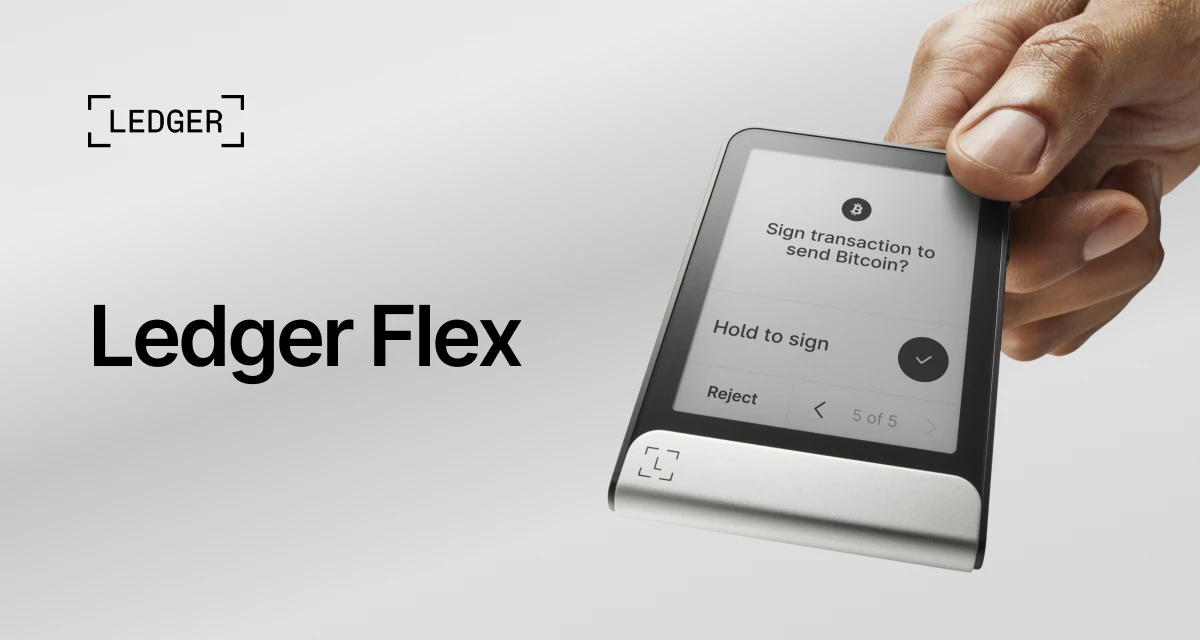
The Ledger Flex is a mid-range hardware wallet released on July 26, 2024, priced at $249 (€249). t features a 2.84‑inch E‑Ink touchscreen with 16 shades of gray.
This secure touchscreen is the first of its kind, driven directly by Ledger’s CC EAL6+ certified Secure Element chip. The device supports USB‑C, Bluetooth 5.2, and NFC connections, working with Windows, macOS, Linux, iOS 13+, and Android 9+ systems. You can install around 10–12 crypto apps, limited by the 1.7 MB internal storage. (Read Ledger Flex review)
Read: Ledger Flex vs Ledger Stax
Key Features
- Secure E‑Ink Touchscreen: The 2.84″ screen displays 16 shades of gray. It is driven directly by the CC EAL6+ secure element, so your taps and swipes are protected.
- Versatile Connectivity: You can connect via USB‑C, Bluetooth 5.2, or NFC to desktop and mobile devices. Also supported is Bluetooth‑based Ledger Security Key login with phones and desktops.
- Long‑Lasting Battery: One full charge gives around 10 hours of active use, equivalent to approximately 150 transactions.
- FIDO2 Security Key Support: With the free Ledger Security Key app, the Flex acts as a FIDO2 token.
4. Ledger Stax: Best for premium and flagship experience
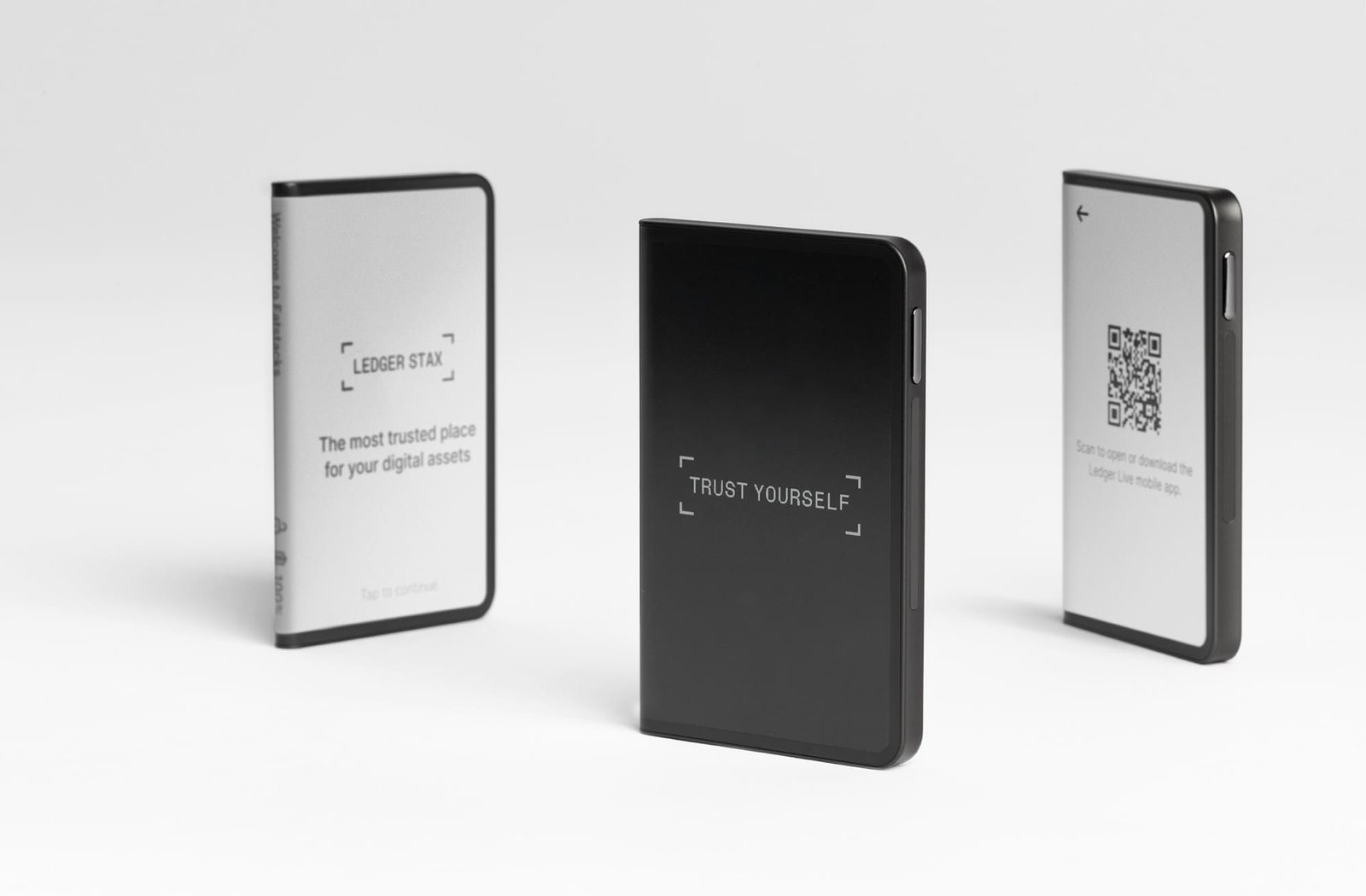
Ledger Stax is a premium, flagship crypto hardware wallet. It has a curved 3.7″ E Ink touchscreen that is easy to read in any light. It supports over 5,500 coins and tokens and works with more than 50 third-party wallets like MetaMask and MyEtherWallet.
The Stax runs on Ledger’s secure operating system and uses a certified CC EAL 6+ Secure Element chip, the same type used in many banking systems. Battery life is strong, lasting up to 10 hours of active use and several days in standby mode. Charging is possible through USB-C or Qi wireless. The device includes a magnetic shell that lets you stack multiple Stax wallets together. You can also customize the lock screen by adding your favorite NFT or image and naming the device on its side panel. The retail price is around $399, which makes it the most expensive model in the Ledger wallet lineup. (Ledger Stax review)
Key Features
- Curved 3.7″ E Ink touchscreen: The large grayscale display lets you review transactions and NFTs clearly. It works well outdoors and uses low power.
- Wide asset support: You can manage over 5,500 digital assets and NFTs. The wallet supports native apps and over 50 external integrations.
- Battery with wireless charging: It offers up to 10 hours of use. You can recharge it using a USB-C cable or any Qi wireless charger.
- Magnetic shell and screen customization: Devices can be stacked easily using the magnetic case. You can personalize the lock screen and name your device.
- Secure signing and multiple connections: Transaction details are shown in full. It supports USB-C, Bluetooth 5.2, and even NFC for extra flexibility.
Ledger Wallet Review: Model Price or Cost
Ledger wallet prices range from $79 to $399, depending on the model and features. Nano S Plus is the cheapest option, while Ledger Stax is the most expensive. Prices can change slightly based on region or seasonal offers. Here is what price we found during our Ledger wallet review:
| Model | Price (USD) | Key Feature |
|---|---|---|
| Nano S Plus | $79 | Affordable, USB-C |
| Nano X | $149 | Bluetooth, Mobile support |
| Ledger Flex | $249 | Flexible display, Lightweight |
| Ledger Stax | $399 | E Ink screen, Wireless charge |
Ledger Wallet Review: Pros & Cons
What I Like About Ledger Wallets
- Private keys are stored offline using a secure element chip (EAL5+ certified).
- Supports 5,500+ coins and tokens, including NFTs and DeFi apps.
- Works with Bluetooth, USB-C, and Ledger Live app across all major platforms.
- BOLOS operating system protects apps with strict isolation inside the secure element.
- Transaction approval is required on the physical device screen to prevent remote tampering.
- Frequent security audits by Ledger Donjon’s white-hat team improve firmware safety.
What I Don’t Like About Ledger Wallets
- Firmware and OS are not fully open-source, which reduces transparency.
- Nano X battery is non-replaceable and can die within 2–3 years.
- Only a limited number of apps can be installed at once on the device.
- Bluetooth feature may expose potential attack surface and drains battery faster.
- ‘Ledger Recover’ feature raised privacy concerns by storing seed fragments externally.
Ledger Wallet Features Explained
Security Measures
You will feel safe when you use a Ledger wallet. The device uses a special secure element chip. This chip has high-level certifications such as EAL5+ or EAL6+. This is the same kind of chip used in passports and bank cards. It keeps your private keys inside the device.

Keys never leave the device. This means hackers on the internet cannot steal your private keys. All operations happen inside the secure chip. The device includes anti‑tampering checks. It verifies at startup that the firmware is genuine.
Ledger also runs a bounty program with a white‑hat security team called Ledger Donjon. This team tests devices to find and fix vulnerabilities. They check third-party apps, fight side-channel attacks, and ensure only valid apps run on the device.
For transactions, you must confirm each transaction manually on the device screen. The screen is secure: it shows the exact destination address and amount. This prevents malware from tricking you. Combined, these layers form a strong security model. It protects you from both remote and physical attacks.
Related: Best crypto hardware wallets
Custom-built BOLOS Operating System
BOLOS stands for Blockchain Open Ledger Operating System. It is built by Ledger specifically for its devices. BOLOS runs all apps inside the secure element. It isolates each app so that they cannot interfere with each other. That means your private keys stay safe even if one app misbehaves.
BOLOS also powers the secure screen, which displays accurate transaction details. It enforces a root-of-trust system so you can verify you have a genuine Ledger device. The OS ensures supply‑chain security by checking firmware integrity at startup.

Developers can still create apps for Ledger without accessing private key secrets. All cryptographic secrets stay locked inside BOLOS. The system follows BIP‑39 and BIP‑32 standards. BOLOS securely manages the device keypair and master node derived from your recovery phrase.
By design, it never exposes these secrets to any app. Ledger does not open‑source BOLOS, but the design and operation are transparent in the documentation. This OS is critical to how Ledger protects your funds with robust isolation and trusted execution.
PIN and Passphrase Protection
You must set a 4‑ to 8‑digit PIN when you first use your Ledger device. This PIN is your first layer of access control. If you enter the wrong PIN three times in a row, the device will reset to factory settings. That erases all private keys stored on the device.
You will need your 24‑word recovery phrase to restore your wallet. Your PIN protects your crypto even if someone steals your physical device.

In addition to a PIN, Ledger offers an optional passphrase security layer. It is sometimes called a “25th word.” You can type the passphrase manually each time (temporary mode), or link it to a second PIN. If you link it, entering the secondary PIN unlocks a hidden wallet.
This gives plausible deniability: you can show a low‑balance wallet if forced, while your main funds stay hidden. The passphrase is never stored on the device. It is used in memory to derive a secondary seed during each unlock. If you restart the device in temporary mode, that data is erased. If you attach it to a PIN, the derived keys stay in the secure element only while unlocked.
Connectivity Types
Ledger offers different models with different ways to connect. Most devices have a USB‑C port. You plug in via cable to your computer or phone. This connection is fast and secure. It is the main method for Nano S Plus, Nano X, Flex, and Stax.
Some Ledger wallets like Nano X, Flex, and Stax also support Bluetooth Low Energy (BLE). This lets you connect wirelessly to mobile devices. Bluetooth is optional, and you can disable it in device settings. Wireless connection is convenient for on‑the‑go use.
Flex and Stax also support NFC. This is useful for quick taps on compatible phones. Connectivity always requires you to confirm transactions on the device. You see the destination address and amount on your Ledger screen. This ensures what you see is what you sign.
We found in our Ledger wallet review that they are compatible with Windows, macOS, Linux, Android, and iOS. Ledger Live software is required to manage the device, install apps, and update firmware. The combination of cable, Bluetooth, and NFC gives flexibility while keeping strong security everywhere.
Ledger Wallet Supported Coins
Ledger wallets support over 5,500 cryptocurrencies, tokens, and NFTs. Major coins like Bitcoin, Ethereum, XRP, Cardano, Solana, and BNB are fully supported.
You can also store stablecoins like USDT and USDC. ERC‑20, BEP‑20, and other token standards are supported through apps.
Ledger works with Bitcoin-based coins like Litecoin, Dogecoin, and Dash. NFT support is available for Ethereum, Polygon, and others using Ledger Live or third-party apps. You can manage coins directly in Ledger Live or connect to external wallets like MetaMask for advanced use.
What is Ledger Recover?
Ledger Recover is a paid subscription service that costs $9.99 per month. The service helps you recover your private keys securely if you lose your recovery phrase.
It does not store your actual 24‑word phrase. Instead, it encrypts and splits your wallet’s entropy into three parts. These encrypted parts, called shards, are stored by three separate trusted companies. No single party can access your private key.
To restore access, you need to verify your identity using a government-issued ID and a selfie. After this check, two out of the three encrypted shards are sent back to your Ledger device. They get reassembled securely inside the device, not on any server.
You also get a unique recovery code on your Ledger screen, which must be confirmed. In our Ledger wallet review, ee found that this service also includes theft protection up to $50,000. Ledger allows three recoveries per month and ten per year. This service is optional, and you can cancel it anytime.
Key Features
- Monthly subscription at $9.99: The service charges a flat monthly fee. The payment gets billed in your local currency but converted to EUR at the time of renewal.
- Fragmented key encryption: Your wallet’s entropy is encrypted and split into three pieces. These pieces are useless on their own, so even if one is compromised, your wallet stays safe.
- Multi-party storage security: Each of the three shards is stored by a different company using secure hardware. No company can access the full key.
- Identity-verified recovery process: To recover your wallet, you must submit your ID and selfie. A one-time security code also appears on your Ledger device for extra verification.
The Ledger Live App Reviewed

Ledger Live is the official app developed by Ledger to manage your crypto directly with your Ledger hardware wallet. It works on both desktop and mobile, and it supports Windows, macOS, Linux, Android, and iOS. The app acts as the central dashboard for all Ledger devices, like Nano X, Nano S Plus, and Ledger Stax. You can use it to install apps, manage crypto accounts, send or receive assets, and monitor your portfolio in real time.
The app supports over 5,500 coins and tokens, including Bitcoin, Ethereum, Solana, and many ERC-20 tokens. You can also use it for staking supported coins like Ethereum, Solana, Polkadot, and more. It shows clear rewards and lets you manage validators without needing third-party tools.
Ledger Live is fully integrated with buy, sell, swap, and grow features. You can buy crypto using bank cards, Apple Pay, or bank transfers directly inside the app. For swapping coins, Ledger Live connects with trusted third-party providers like Changelly or 1inch, but your keys always stay offline on the device.
It also offers a clear security check before every transaction. You must confirm each operation on your physical Ledger device, which prevents remote hacking. Ledger Live is the only official app that connects directly to your Ledger hardware without exposing your private keys.
In this Ledger wallet review, we found that you can also use the app to access Ledger Recover (if subscribed), view NFTs (on Ethereum and Polygon), and manage multiple wallets or accounts under one view. It includes a password lock, data encryption, and syncing between desktop and mobile if you use both.
Ledger Wallet Review: How to Set Up and Use It?
- Install Ledger Live App and Set Up Your Device: Download and install the Ledger Live app from the official Ledger website. Open the app and click on “Get Started”. Choose your Ledger model (Nano X, Nano S Plus, or Stax). Now select “Set up as new device” on your hardware wallet screen. You’ll be asked to choose a PIN code (4–8 digits). After that, write down the 24-word recovery phrase shown on the device. Confirm it word by word using device buttons.
- Pair Device with Ledger Live: Once the device is set up, return to the Ledger Live app. Click “Add new device” and follow the prompts. Connect the Ledger wallet using USB or Bluetooth (for Nano X). When prompted, allow Ledger Manager access on your device. The app will perform a genuine check to confirm your device is official and secure.
- Add Crypto Accounts: Click on “Accounts” from the left sidebar. Press “Add Account”. Select the crypto asset (like Bitcoin or Ethereum), then connect and unlock your Ledger device. Open the related app (e.g., “Bitcoin” app) on the device when asked. Ledger Live will sync and create your account.
- Receive and Send Crypto: Go to “Accounts”, choose the wallet, then click “Receive” or “Send”. For receiving, open the app on your Ledger device and verify the displayed address. For sending, enter recipient address and amount, confirm on the Ledger screen, and approve.
- Manage, Stake, and Swap: Use tabs like “Discover”, “Buy/Sell”, and “Earn” to stake, swap, or grow assets. All actions need device confirmation, keeping your funds secure.
FAQs on Ledger Crypto Wallet Review
How does the Ledger wallet work?
A Ledger wallet stores your private crypto keys offline inside a secure chip. It connects with the Ledger Live app, and every transaction must be verified using physical buttons on the device. Your private keys never leave the wallet.
Ledger works as a hardware wallet. It keeps your crypto keys away from the internet, which blocks hacking or malware access. When you want to send or receive coins, the Ledger device signs the transaction securely inside the device. This keeps your assets safe even if your computer is compromised.
Where can you buy a Ledger crypto Wallet?
You can buy Ledger wallets directly from Ledger’s official website or through authorized resellers listed on their site. Avoid third-party marketplaces.
Always buy from the official source to make sure the device is genuine and not tampered with. Ledger sells its wallets through its online store, and shipping is available to most countries. If buying elsewhere, check Ledger’s list of approved sellers to avoid fake products that could steal your crypto.
Are Ledger wallets good?
Yes, Ledger wallets are known for strong security, ease of use, and wide coin support. They work with 5,500+ tokens and support staking, NFTs, and DeFi.
Ledger cryptocurrency wallets are trusted by millions of users. The devices use certified secure chips and offer recovery options. You can use them with the Ledger Live app, which makes crypto storage simple. They also work with third-party wallets and apps, which gives more flexibility to advanced users.
Is Ledger safer than the Trezor wallet?
Ledger is safer in hardware design due to its certified secure chip. Trezor uses open-source software but does not include a secure element chip in Trezor Model T. However, Trezor’s latest models also have an EAL6+ chipset.
However, both are secure and widely trusted. It depends on whether you prefer closed-source hardware (Ledger) or open-source transparency (Trezor).
How safe is the Ledger wallet?
Ledger wallets are very safe. They keep your private keys offline and require physical confirmation for every action. The wallet uses a secure chip that blocks remote attacks.
Even if your phone or computer gets hacked, your funds cannot be stolen without the device and your PIN. Ledger’s system never shares the actual private key. It only signs transactions inside the secure chip, which adds another layer of protection that software wallets don’t offer.
Is Ledger wallet worth it?
Yes, it’s worth it if you hold a good amount of crypto and want strong offline protection. It gives full control and reduces hacking risk.
What’s the best Ledger wallet?
Ledger Nano X is the best all-round wallet. It has Bluetooth, a larger screen, and supports more apps at once compared to other models.
Our Ledger wallet review saw that Nano X is good for both beginners and advanced users. It can install up to 100+ apps, works with iOS and Android, and holds many coins at once. It’s more flexible than Nano S Plus, and cheaper than Ledger Stax. If you need only basic storage, Nano S Plus is still a solid option.
